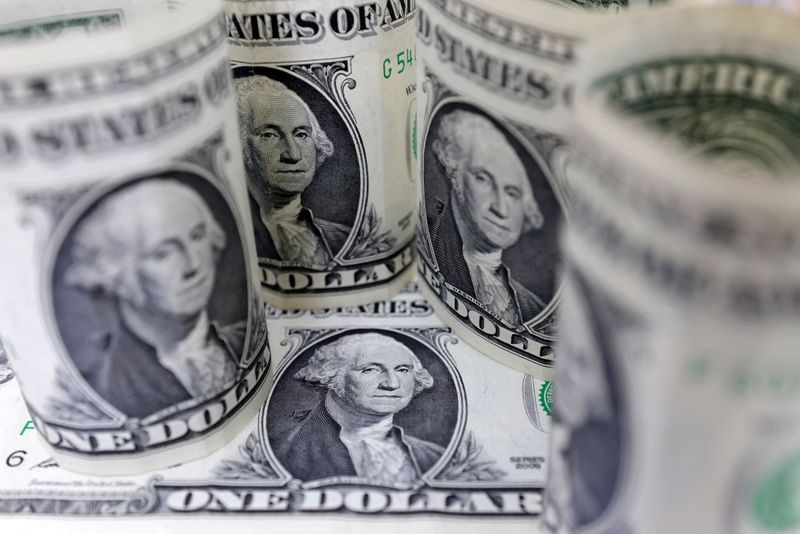Forex
Dollar slips as FX traders gird for US election outcome

By Amanda Cooper
LONDON (Reuters) -The dollar eased on Tuesday as traders squared positions ahead of what is expected to be a close U.S. presidential election, while options volatility soared after recent polls dented some market bets on a victory for Republican Donald Trump.
Democrat Kamala Harris has also experienced improving odds on election gambling sites and had a slight lead on PredictIt overnight, although Polymarket continued to show Trump as favourite.
In recent weeks, financial markets and some betting platforms had leaned strongly in favour of a win for Trump, whose tariff and immigration policies are considered inflationary by analysts, leading to a rise in U.S. Treasury yields and gains for the dollar.
The U.S. currency took a knock on Monday (NASDAQ:) after a weekend opinion poll showed Harris with a surprise lead in Iowa, a traditional Republican stronghold. Overall, polls continue to show a tight race.
With hours to go until the first results emerge overnight, the dollar was mostly flat against a basket of currencies.
Traders were less sanguine about the outlook over the coming 24 hours and rushed to hedge against potentially huge price moves in currencies that are particularly sensitive to the outcome of the election and U.S. trade policy, such as the euro and the Mexican peso.
Overnight options volatility spiked to its highest since 2016 for the euro and the peso.
“The big story is that big spike we’ve seen in overnight vol,” Pepperstone senior research strategist Michael Brown said.
“Euro overnight vols just now are at their highest level since the Brexit referendum, which perhaps gives you an idea of some of the moves that markets are bracing for over the next 24 hours or so.”
According to LSEG data, euro overnight vol hit its highest since November 2016, but on other platforms, it rose to the most since June 2016, when Britain voted to leave the European Union.
Implied options volatility reflects demand from traders to buy protection against wild price swings and this might not always reflect action in the underlying market.
“Today everything is just ‘wait and see’. Nobody is going to be have any conviction whatsoever until we start getting the first results overnight and that’s where you’ll see markets start to jump around,” Brown said.
The euro () rose 0.17% to $1.08955, while the pound was up 0.2% at $1.2987 and the yen was broadly steady on the day at 152.275.
“We judge financial markets are now positioned for a Harris win,” said Carol Kong, a currency strategist at Commonwealth Bank of Australia (OTC:).
“The USD can therefore fall modestly by 1%‑2% this week if Vice President Harris wins and lift materially if (former) President Trump wins,” she said. “Any delays and/or disputes over vote counting can also add to currency volatility this week.”
UNCERTAINTY ALL ROUND
The winner may not be known for days after Tuesday’s vote, though Trump has already signalled that he will attempt to fight any defeat, as he did in 2020.
rose 2.7% to $68,893, having touched a one-week low of $66,776.19 earlier. Trump is viewed by analysts as enacting more favourable policies for cryptocurrencies than Harris.
Complicating the picture even more for traders this week is the Federal Reserve’s policy meeting on Thursday, at which the U.S. central bank is expected to cut interest rates by a quarter point. Markets will focus on any clues that the U.S. central bank could skip a cut in December, after last week’s monthly jobs report showed employers added far fewer jobs than economists had expected in October, raising questions over the degree of softness in the labour market.
The Bank of England, Sweden’s Riksbank and Norway’s central bank all hold policy meetings on Thursday too.
The Reserve Bank of Australia held policy steady on Tuesday, as widely expected, and retained wording in its statement that “policy will need to be sufficiently restrictive until the Board is confident that inflation is moving sustainably towards the target range.”

RBA Governor Michele Bullock sounded a more hawkish note in her news conference, saying she still believed there are upside risks for inflation.
The Australian dollar rose 0.58% to $0.6624, finding its footing after hitting its weakest since Aug. 8 last week at $0.6537.

 Forex3 years ago
Forex3 years agoForex Today: the dollar is gaining strength amid gloomy sentiment at the start of the Fed’s week

 Forex3 years ago
Forex3 years agoUnbiased review of Pocket Option broker

 Forex3 years ago
Forex3 years agoDollar to pound sterling exchange rate today: Pound plummeted to its lowest since 1985

 Forex3 years ago
Forex3 years agoHow is the Australian dollar doing today?

 Cryptocurrency3 years ago
Cryptocurrency3 years agoWhat happened in the crypto market – current events today

 World3 years ago
World3 years agoWhy are modern video games an art form?

 Commodities3 years ago
Commodities3 years agoCopper continues to fall in price on expectations of lower demand in China

 Economy3 years ago
Economy3 years agoCrude oil tankers double in price due to EU anti-Russian sanctions





















